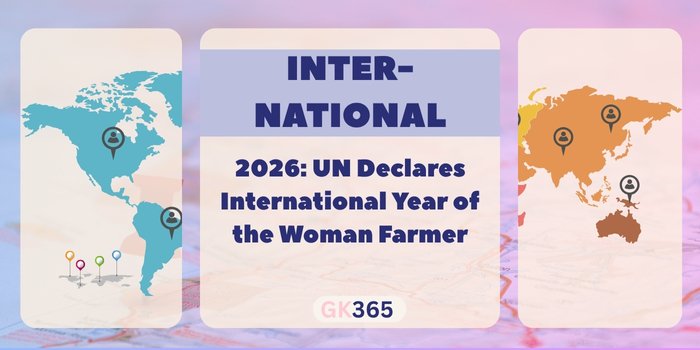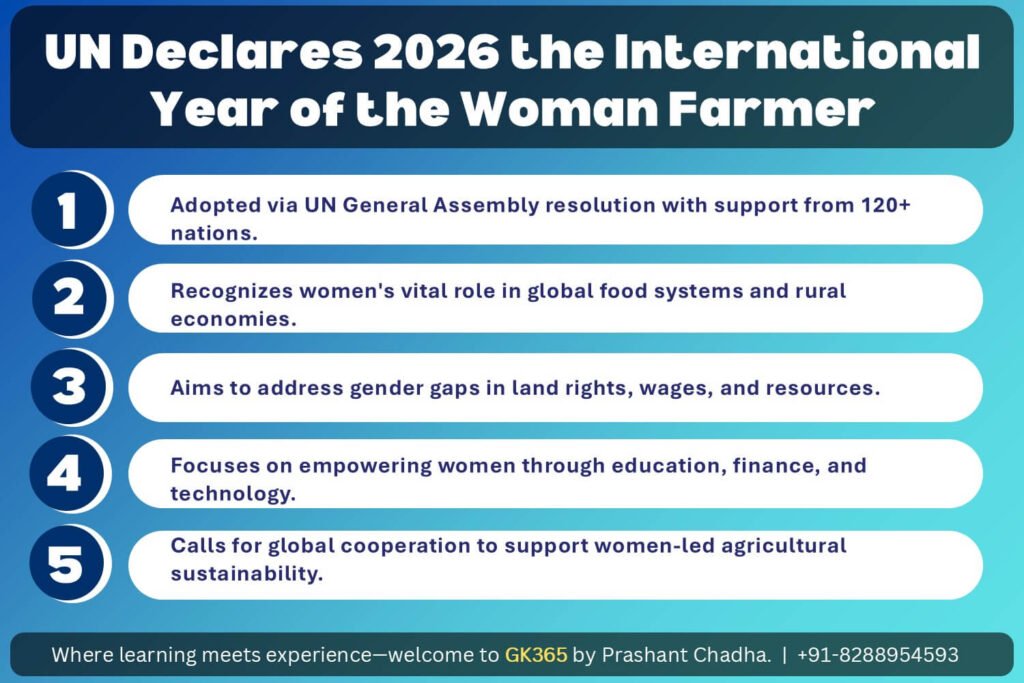Introduction
The United Nations General Assembly has declared 2026 the International Year of the Woman Farmer. The resolution highlights the vital role women play in agriculture and calls attention to the inequalities they face. The aim is to promote policies that give women equal access to land, tools, markets, and decision-making.
Women grow nearly half the world’s food. Yet they have fewer rights, less support, and limited access to resources. In India, about 80% of working women are in agriculture, but they own only 8.3% of farmland. This global observance offers a chance to fix that imbalance.
Table of Contents
- Why in News?
- Understanding the International Year of the Woman Farmer
- Women in Global Agriculture: Key Statistics
- Women Farmers in India: Reality Check
- Key Challenges Faced by Women Farmers
- Government Initiatives in India
- Global Best Practices and Case Studies
- Policy Recommendations for Gender-Equitable Agriculture
- Significance of the 2026 UN Declaration
- FAQs
- Conclusion & Call-to-Action
- Key Takeaways Table
Why in News?
The UN General Assembly has designated 2026 as the International Year of the Woman Farmer. The goal is to raise global awareness about women’s role in farming and push for fairer agricultural policies. The resolution targets gender gaps in land rights, finance, technology, and leadership—especially in countries where women form the majority of the farm workforce.
In India, this recognition is overdue. Although women make up nearly 80% of agricultural workers, they own less than 10% of land and struggle to access credit, farm tools, and modern tech.
Understanding the International Year of the Woman Farmer
This observance goes beyond symbolism. It supports three key goals:
- Recognizing women’s work: Women grow 50% of the world’s food but rarely shape policy.
- Closing gender gaps: The effort focuses on land rights, financial tools, and value chains.
- Promoting climate resilience: It encourages sustainable farming and use of climate-smart tools.
This aligns with UN Sustainable Development Goals—especially Goal 5 (Gender Equality) and Goal 2 (Zero Hunger).
Women in Global Agriculture: Key Statistics
- Women grow ~50% of the world’s food globally.
- In Africa and Asia, women produce 60–80% of the food.
- India:
- 80% of working women are in agriculture.
- Only 8.3% of farmland is owned by women (NFHS).
- 76.95% of rural women work in agri-related jobs (PLFS 2023–24).
- 51% of rural women aged 15+ lack mobile phones (NSO), limiting access to agri-advice and market data.
Women Farmers in India: Reality Check
- Land ownership: Just 8.3% of women own farmland, limiting credit access and policy benefits.
- Unpaid labor: 77% of rural women work in agriculture, often without pay or recognition.
- Digital divide: Over half of rural women do not own a mobile phone, cutting them off from weather alerts, crop advisories, and pricing tools.
- Policy gaps: Many government schemes do not address women’s specific needs or fail in execution.
Key Challenges Faced by Women Farmers
- Dual workload: Household duties reduce time and energy for farming.
- No land rights: Without legal titles, women cannot access credit, subsidies, or insurance.
- Limited finance: Microloans are too small for real change; few get support for long-term needs.
- Low tech access: Without smartphones or internet, women miss out on key advisories and schemes.
- Climate risks: Women are more vulnerable to floods, droughts, and irregular weather, with fewer resources to respond.
Government Initiatives in India
- MKSP: Trains women and improves access to farm tools.
- Farm Mechanisation Scheme: Offers 50–80% subsidy on tools and equipment.
- National Food Security Mission: Some states reserve 30% of funds for women.
- SHG Networks: Encourage joint farming and financial freedom.
Global Best Practices and Case Studies
ENACT Project (Assam, India)
- Led by the World Food Programme and the Assam government.
- Uses mobile-based climate alerts to support women farmers.
- Encourages climate-resilient crops and better seed systems.
International Examples
- FAO Partnerships: Support women-run cooperatives.
- Kenya’s Women-Only Groups: Help women access loans and technology.
Policy Recommendations for Gender-Equitable Agriculture
- Use gender data: Design plans using male–female comparisons.
- Secure land rights: Simplify land transfers and inheritance for women.
- Expand finance: Offer loans, insurance, and support targeted at women.
- Improve tech access: Provide devices and digital training.
- Back women-led ventures: Strengthen SHGs and co-ops.
- Change records: List women as “farmers,” not “helpers.”
Significance of the 2026 UN Declaration
- Pushes for equal growth in agriculture.
- Supports climate-ready farming through women’s involvement.
- Fights structural injustice in rural economies.
- Strengthens global food security.
FAQs
- Why did the UN declare 2026 as the International Year of the Woman Farmer?
To honor women’s role in farming and promote fairer systems. - What is the contribution of women to global agriculture?
They grow about 50% of food globally; up to 80% in some developing areas. - What challenges do women farmers face in India?
They lack land rights, credit access, tech tools, and face climate shocks. - What programs support women farmers in India?
MKSP, farm subsidies, and SHG networks aim to close gender gaps. - How does empowering women help food security?
Closing the gender gap could raise food output by up to 30%.
Conclusion & Call-to-Action
The 2026 declaration is more than a headline. It’s a push for action. Empowering women in agriculture is key to reducing hunger, improving incomes, and meeting UN goals. Governments, institutions, and communities must act now—by giving women farmers land, tools, and a voice in shaping the future.
Stay updated on global policy and sustainability at GK365.in
Key Takeaways Table
| Category | Details |
|---|---|
| Declaration | 2026 declared the International Year of the Woman Farmer by the UN General Assembly |
| Global Aim | Highlight women’s vital role in agriculture and promote gender-equal access to land, tools, finance, markets, and decision-making |
| Why It Matters | Women produce ~50% of the world’s food but face limited rights, recognition, and resources |
| India-Specific Stats | – 80% of working women are in agriculture- Only 8.3% own farmland– 51% lack mobile phones, limiting access to digital tools |
| Key Challenges | – No land rights- Low financial access- Heavy unpaid work- Lack of digital inclusion- High vulnerability to climate shocks |
| Major Government Schemes | – MKSP, Farm Mechanisation Scheme, National Food Security Mission (30% funds for women in some states), SHG networks |
| Notable Global Practices | – ENACT project (Assam): mobile alerts + climate-smart seeds- FAO & Kenya’s women groups: support co-ops, finance, and tech access |
| UN Goals Supported | – Goal 2 (Zero Hunger)– Goal 5 (Gender Equality) |
| Policy Recommendations | – Secure land rights- Gender-disaggregated data- Digital training- SHG support- Recognize women as official “farmers” |
| Significance of 2026 | Seen as a global policy window to reshape rural gender equity, boost food security, and promote climate-resilient agriculture |



